Min-Yen Kan
Columbia University
SkyLadder: Better and Faster Pretraining via Context Window Scheduling
Mar 19, 2025Abstract:Recent advancements in LLM pretraining have featured ever-expanding context windows to process longer sequences. However, our pilot study reveals that models pretrained with shorter context windows consistently outperform their long-context counterparts under a fixed token budget. This finding motivates us to explore an optimal context window scheduling strategy to better balance long-context capability with pretraining efficiency. To this end, we propose SkyLadder, a simple yet effective approach that implements a short-to-long context window transition. SkyLadder preserves strong standard benchmark performance, while matching or exceeding baseline results on long context tasks. Through extensive experiments, we pre-train 1B-parameter models (up to 32K context) and 3B-parameter models (8K context) on 100B tokens, demonstrating that SkyLadder yields consistent gains of up to 3.7% on common benchmarks, while achieving up to 22% faster training speeds compared to baselines. The code is at https://github.com/sail-sg/SkyLadder.
Evaluating Sakana's AI Scientist for Autonomous Research: Wishful Thinking or an Emerging Reality Towards 'Artificial Research Intelligence' (ARI)?
Feb 22, 2025Abstract:A major step toward Artificial General Intelligence (AGI) and Super Intelligence is AI's ability to autonomously conduct research - what we term Artificial Research Intelligence (ARI). If machines could generate hypotheses, conduct experiments, and write research papers without human intervention, it would transform science. Sakana recently introduced the 'AI Scientist', claiming to conduct research autonomously, i.e. they imply to have achieved what we term Artificial Research Intelligence (ARI). The AI Scientist gained much attention, but a thorough independent evaluation has yet to be conducted. Our evaluation of the AI Scientist reveals critical shortcomings. The system's literature reviews produced poor novelty assessments, often misclassifying established concepts (e.g., micro-batching for stochastic gradient descent) as novel. It also struggles with experiment execution: 42% of experiments failed due to coding errors, while others produced flawed or misleading results. Code modifications were minimal, averaging 8% more characters per iteration, suggesting limited adaptability. Generated manuscripts were poorly substantiated, with a median of five citations, most outdated (only five of 34 from 2020 or later). Structural errors were frequent, including missing figures, repeated sections, and placeholder text like 'Conclusions Here'. Some papers contained hallucinated numerical results. Despite these flaws, the AI Scientist represents a leap forward in research automation. It generates full research manuscripts with minimal human input, challenging expectations of AI-driven science. Many reviewers might struggle to distinguish its work from human researchers. While its quality resembles a rushed undergraduate paper, its speed and cost efficiency are unprecedented, producing a full paper for USD 6 to 15 with 3.5 hours of human involvement, far outpacing traditional researchers.
Exploring Multi-Grained Concept Annotations for Multimodal Large Language Models
Dec 08, 2024



Abstract:Multimodal Large Language Models (MLLMs) excel in vision--language tasks by pre-training solely on coarse-grained concept annotations (e.g., image captions). We hypothesize that integrating fine-grained concept annotations (e.g., object labels and object regions) will further improve performance, as both data granularities complement each other in terms of breadth and depth in concept representation. We introduce a new dataset featuring Multimodal Multi-Grained Concept annotations (MMGiC) for MLLMs. In constructing MMGiC, we explore the impact of different data recipes on multimodal comprehension and generation. Our analyses reveal that multi-grained concept annotations integrate and complement each other, under our structured template and a general MLLM framework. We clearly explore and demonstrate the potential of MMGiC to help MLLMs better locate and learn concepts, aligning vision and language at multiple granularities. We further validate our hypothesis by investigating the fair comparison and effective collaboration between MMGiC and image--caption data on 12 multimodal comprehension and generation benchmarks, e.g., their appropriate combination achieve 3.95% and 2.34% absolute improvements over image--caption data alone on POPE and SEED-Bench. Code, data and models will be available at https://github.com/LooperXX/MMGiC.
Reasoning Robustness of LLMs to Adversarial Typographical Errors
Nov 08, 2024



Abstract:Large Language Models (LLMs) have demonstrated impressive capabilities in reasoning using Chain-of-Thought (CoT) prompting. However, CoT can be biased by users' instruction. In this work, we study the reasoning robustness of LLMs to typographical errors, which can naturally occur in users' queries. We design an Adversarial Typo Attack ($\texttt{ATA}$) algorithm that iteratively samples typos for words that are important to the query and selects the edit that is most likely to succeed in attacking. It shows that LLMs are sensitive to minimal adversarial typographical changes. Notably, with 1 character edit, Mistral-7B-Instruct's accuracy drops from 43.7% to 38.6% on GSM8K, while with 8 character edits the performance further drops to 19.2%. To extend our evaluation to larger and closed-source LLMs, we develop the $\texttt{R$^2$ATA}$ benchmark, which assesses models' $\underline{R}$easoning $\underline{R}$obustness to $\underline{\texttt{ATA}}$. It includes adversarial typographical questions derived from three widely used reasoning datasets-GSM8K, BBH, and MMLU-by applying $\texttt{ATA}$ to open-source LLMs. $\texttt{R$^2$ATA}$ demonstrates remarkable transferability and causes notable performance drops across multiple super large and closed-source LLMs.
V-DPO: Mitigating Hallucination in Large Vision Language Models via Vision-Guided Direct Preference Optimization
Nov 05, 2024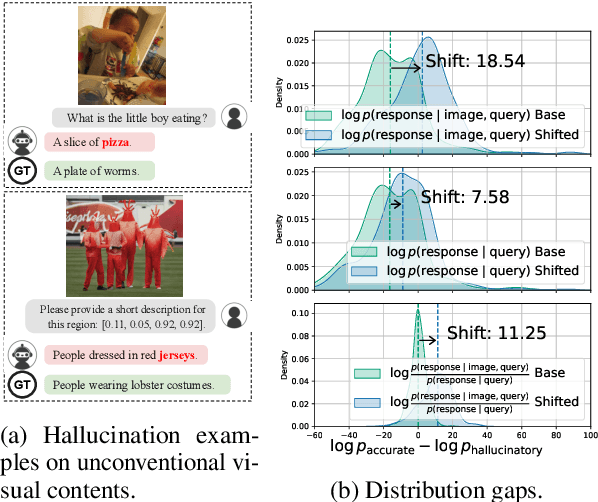
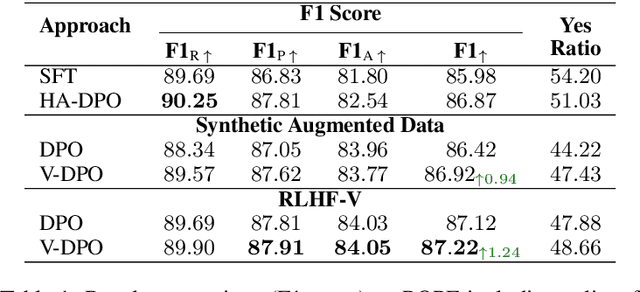
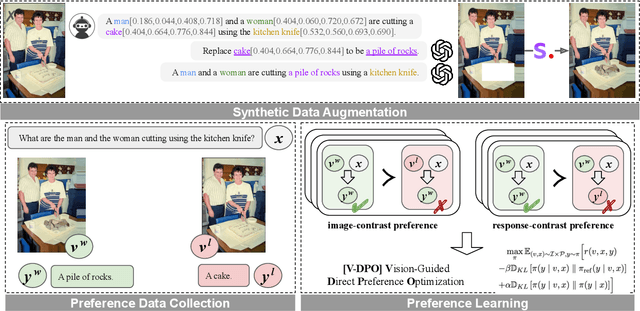
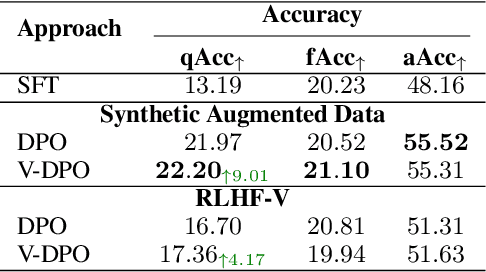
Abstract:Large vision-language models (LVLMs) suffer from hallucination, resulting in misalignment between the output textual response and the input visual content. Recent research indicates that the over-reliance on the Large Language Model (LLM) backbone, as one cause of the LVLM hallucination, inherently introduces bias from language priors, leading to insufficient context attention to the visual inputs. We tackle this issue of hallucination by mitigating such over-reliance through preference learning. We propose Vision-guided Direct Preference Optimization (V-DPO) to enhance visual context learning at training time. To interpret the effectiveness and generalizability of V-DPO on different types of training data, we construct a synthetic dataset containing both response- and image-contrast preference pairs, compared against existing human-annotated hallucination samples. Our approach achieves significant improvements compared with baseline methods across various hallucination benchmarks. Our analysis indicates that V-DPO excels in learning from image-contrast preference data, demonstrating its superior ability to elicit and understand nuances of visual context. Our code is publicly available at https://github.com/YuxiXie/V-DPO.
Multi-expert Prompting Improves Reliability, Safety, and Usefulness of Large Language Models
Nov 01, 2024Abstract:We present Multi-expert Prompting, a novel enhancement of ExpertPrompting (Xu et al., 2023), designed to improve the large language model (LLM) generation. Specifically, it guides an LLM to fulfill an input instruction by simulating multiple experts, aggregating their responses, and selecting the best among individual and aggregated responses. This process is performed in a single chain of thoughts through our seven carefully designed subtasks derived from the Nominal Group Technique (Ven and Delbecq, 1974), a well-established decision-making framework. Our evaluations demonstrate that Multi-expert Prompting significantly outperforms ExpertPrompting and comparable baselines in enhancing the truthfulness, factuality, informativeness, and usefulness of responses while reducing toxicity and hurtfulness. It further achieves state-of-the-art truthfulness by outperforming the best baseline by 8.69% with ChatGPT. Multi-expert Prompting is efficient, explainable, and highly adaptable to diverse scenarios, eliminating the need for manual prompt construction.
DataTales: A Benchmark for Real-World Intelligent Data Narration
Oct 23, 2024Abstract:We introduce DataTales, a novel benchmark designed to assess the proficiency of language models in data narration, a task crucial for transforming complex tabular data into accessible narratives. Existing benchmarks often fall short in capturing the requisite analytical complexity for practical applications. DataTales addresses this gap by offering 4.9k financial reports paired with corresponding market data, showcasing the demand for models to create clear narratives and analyze large datasets while understanding specialized terminology in the field. Our findings highlights the significant challenge that language models face in achieving the necessary precision and analytical depth for proficient data narration, suggesting promising avenues for future model development and evaluation methodologies.
CCSBench: Evaluating Compositional Controllability in LLMs for Scientific Document Summarization
Oct 16, 2024Abstract:To broaden the dissemination of scientific knowledge to diverse audiences, scientific document summarization must simultaneously control multiple attributes such as length and empirical focus. However, existing research typically focuses on controlling single attributes, leaving the compositional control of multiple attributes underexplored. To address this gap, we introduce CCSBench, a benchmark for compositional controllable summarization in the scientific domain. Our benchmark enables fine-grained control over both explicit attributes (e.g., length), which are objective and straightforward, and implicit attributes (e.g., empirical focus), which are more subjective and conceptual. We conduct extensive experiments on GPT-4, LLaMA2, and other popular LLMs under various settings. Our findings reveal significant limitations in large language models' ability to balance trade-offs between control attributes, especially implicit ones that require deeper understanding and abstract reasoning.
COrAL: Order-Agnostic Language Modeling for Efficient Iterative Refinement
Oct 12, 2024



Abstract:Iterative refinement has emerged as an effective paradigm for enhancing the capabilities of large language models (LLMs) on complex tasks. However, existing approaches typically implement iterative refinement at the application or prompting level, relying on autoregressive (AR) modeling. The sequential token generation in AR models can lead to high inference latency. To overcome these challenges, we propose Context-Wise Order-Agnostic Language Modeling (COrAL), which incorporates iterative refinement directly into the LLM architecture while maintaining computational efficiency. Our approach models multiple token dependencies within manageable context windows, enabling the model to perform iterative refinement internally during the generation process. Leveraging the order-agnostic nature of COrAL, we introduce sliding blockwise order-agnostic decoding, which performs multi-token forward prediction and backward reconstruction within context windows. This allows the model to iteratively refine its outputs in parallel in the sliding block, effectively capturing diverse dependencies without the high inference cost of sequential generation. Empirical evaluations on reasoning tasks demonstrate that COrAL improves performance and inference speed, respectively, achieving absolute accuracy gains of $4.6\%$ on GSM8K and $4.0\%$ on LogiQA, along with inference speedups of up to $3.9\times$ over next-token baselines. Preliminary results on code generation indicate a drop in pass rates due to inconsistencies in order-agnostic outputs, highlighting the inherent quality--speed trade-off. Our code is publicly available at https://github.com/YuxiXie/COrAL.
MVP-Bench: Can Large Vision--Language Models Conduct Multi-level Visual Perception Like Humans?
Oct 06, 2024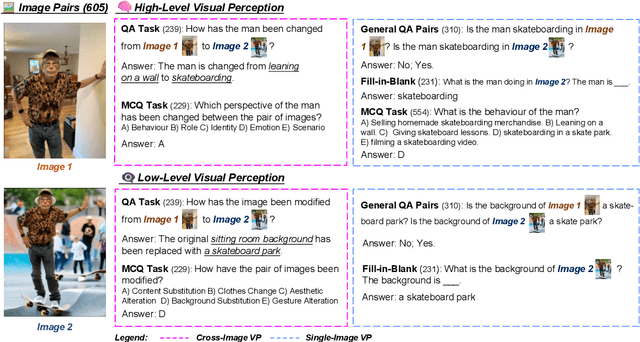

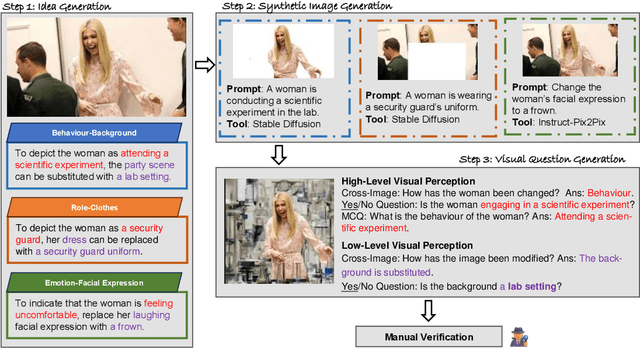
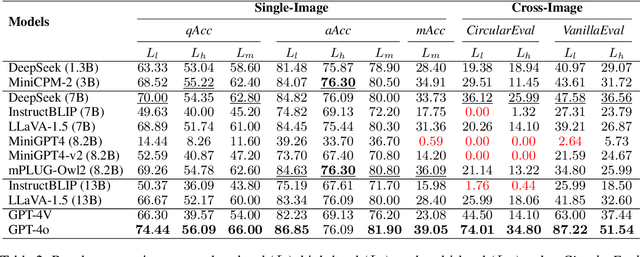
Abstract:Humans perform visual perception at multiple levels, including low-level object recognition and high-level semantic interpretation such as behavior understanding. Subtle differences in low-level details can lead to substantial changes in high-level perception. For example, substituting the shopping bag held by a person with a gun suggests violent behavior, implying criminal or violent activity. Despite significant advancements in various multimodal tasks, Large Visual-Language Models (LVLMs) remain unexplored in their capabilities to conduct such multi-level visual perceptions. To investigate the perception gap between LVLMs and humans, we introduce MVP-Bench, the first visual-language benchmark systematically evaluating both low- and high-level visual perception of LVLMs. We construct MVP-Bench across natural and synthetic images to investigate how manipulated content influences model perception. Using MVP-Bench, we diagnose the visual perception of 10 open-source and 2 closed-source LVLMs, showing that high-level perception tasks significantly challenge existing LVLMs. The state-of-the-art GPT-4o only achieves an accuracy of $56\%$ on Yes/No questions, compared with $74\%$ in low-level scenarios. Furthermore, the performance gap between natural and manipulated images indicates that current LVLMs do not generalize in understanding the visual semantics of synthetic images as humans do. Our data and code are publicly available at https://github.com/GuanzhenLi/MVP-Bench.
 Add to Chrome
Add to Chrome Add to Firefox
Add to Firefox Add to Edge
Add to Edge